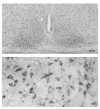Rhythmic coupling among cells in the suprachiasmatic nucleus
- PMID: 10861563
- PMCID: PMC2577317
- DOI: 10.1002/1097-4695(20000615)43:4<379::aid-neu6>3.0.co;2-0
Rhythmic coupling among cells in the suprachiasmatic nucleus
Abstract
In mammals, the part of the nervous system responsible for most circadian behavior can be localized to a pair of structures in the hypothalamus known as the suprachiasmatic nucleus (SCN). Previous studies suggest that the basic mechanism responsible for the generation of these rhythms is intrinsic to individual cells. There is also evidence that the cells within the SCN are coupled to one another and that this coupling is important for the normal functioning of the circadian system. One mechanism that mediates coordinated electrical activity is direct electrical connections between cells formed by gap junctions. In the present study, we used a brain slice preparation to show that developing SCN cells are dye coupled. Dye coupling was observed in both the ventrolateral and dorsomedial subdivisions of the SCN and was blocked by application of a gap junction inhibitor, halothane. Dye coupling in the SCN appears to be regulated by activity-dependent mechanisms as both tetrodotoxin and the GABA(A) agonist muscimol inhibited the extent of coupling. Furthermore, acute hyperpolarization of the membrane potential of the original biocytin-filled neuron decreased the extent of coupling. SCN cells were extensively dye coupled during the day when the cells exhibit synchronous neural activity but were minimally dye coupled during the night when the cells are electrically silent. Immunocytochemical analysis provides evidence that a gap-junction-forming protein, connexin32, is expressed in the SCN of postnatal animals. Together the results are consistent with a model in which gap junctions provide a means to couple SCN neurons on a circadian basis.
Copyright 2000 John Wiley & Sons, Inc.
Figures




References
-
- Balsalobre A, Damiola F, Schibler U. A serum shock induces circadian gene expression in mammalian tissue culture cells. Cell. 1998;93:929–937. - PubMed
-
- Bloomfield SA, Xin D, Osborne T. Light-induced modulation of coupling between AII amacrine cells in the rabbit retina. Vis Neurosci. 1997;14:565–576. - PubMed
-
- Cepeda C, Colwell CS, Itri JN, Chandler SH, Levine MS. Dopaminergic modulation of NMDA-induced whole-cell currents in neostriatal neurons in slices: contribution of calcium conductances. J Neurophysiol. 1998;79:82–94. - PubMed
Publication types
MeSH terms
Substances
Grants and funding
LinkOut - more resources
Full Text Sources
Other Literature Sources
Miscellaneous

